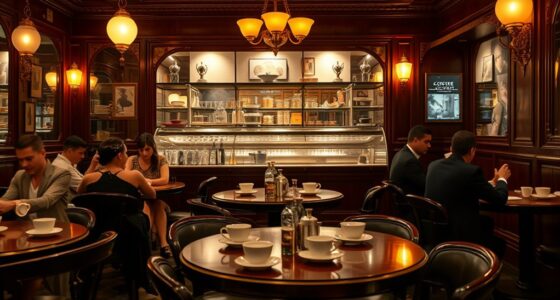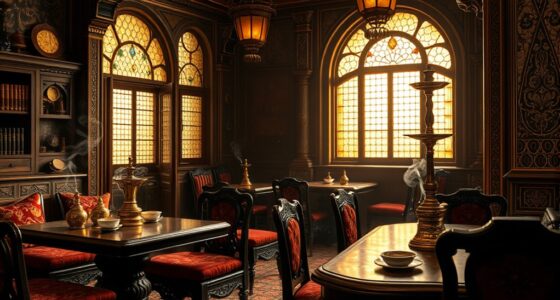Vienna’s coffeehouse culture in the 19th century showcases elegance and intellect, serving as lively social hubs where art, philosophy, and conversation flourish. You’ll find traditional interiors with plush armchairs, marble tables, and mirrors that create an inviting, timeless atmosphere. These cafes weren’t just places for coffee; they were essential centers for debate, literary exchange, and creative ideas that shaped the city’s rich cultural legacy. Discover more about these iconic venues and their fascinating history through what unfolds next.
Key Takeaways
- 19th-century Vienna’s coffeehouses evolved into vibrant social and intellectual hubs, fostering discussion, creativity, and cultural exchange.
- They served as literary salons where prominent writers like Kafka and Zweig gathered, shaping Vienna’s literary identity.
- Traditional interiors with plush armchairs, marble tables, and mirrors created an intimate, timeless atmosphere encouraging lingering and socializing.
- Coffeehouses provided refuges from political upheavals, promoting social integration and breaking social barriers among diverse patrons.
- They continue to influence Vienna’s cultural scene, hosting events and symbolizing the city’s rich artistic and philosophical heritage.

Have you ever wondered why Vienna’s coffeehouses are more than just places to grab a drink? The answer lies in their rich history and cultural significance. These establishments trace their origins back to the late 17th and early 18th centuries, when coffee was first introduced to Vienna through trade routes connecting the Ottoman Empire and Western Europe. It didn’t take long for these cafes to evolve from simple watering holes into vibrant hubs of social and intellectual life. During the 19th century, Vienna’s coffeehouses became essential centers for discussion, creativity, and exchange of ideas, shaping the city’s reputation as a cradle of arts and philosophy. You’ll notice that many of these cafes still preserve their traditional interiors, with plush armchairs, marble tables, and mirrors that reflect their historic charm. These settings foster a sense of intimacy and timelessness, inviting you to linger and engage.
The historical origins of Vienna’s coffeehouse culture are closely tied to the city’s political and social upheavals. As the Austro-Hungarian Empire expanded, coffeehouses became spaces where people from different backgrounds gathered, breaking down social barriers. They offered a refuge from the chaos of daily life, a place to reflect and connect. But beyond their social functions, these cafes also served as literary salons—informal gatherings where writers, poets, and intellectuals would meet to share ideas and debate. Think of them as the city’s living rooms, where minds like Franz Kafka and Stefan Zweig found inspiration. These literary salons helped cultivate a vibrant intellectual scene, making Vienna a magnet for thinkers and artists. Many coffeehouses became synonymous with the city’s literary identity, hosting book launches, poetry readings, and philosophical discussions that continue to influence Vienna’s cultural fabric today.
Frequently Asked Questions
How Did Vienna’s Coffeehouses Influence European Literary Movements?
You see, Vienna’s coffeehouses played a vital role in shaping European literary movements by serving as lively hubs for literary salons and intellectual circles. You’d find writers, poets, and thinkers exchanging ideas over coffee, sparking creativity and debate. These vibrant spaces fostered collaboration, inspired new styles, and helped circulate groundbreaking works, making them essential to the development of modern literature across Europe.
What Unique Coffee Blends Originated in Vienna’S Historic Cafés?
Imagine sipping a cup of Vienna’s signature blend, as if tasting history itself. You’ll find specialty roasts like Melange, a rich mix of coffee and milk, born in these historic cafés. Unique blends, crafted through centuries of tradition, set Vienna apart. These signature blends reflect the city’s elegance and innovation, making each cup a flavorful story. You experience more than coffee—you taste Vienna’s cultural soul.
Are Vienna’S Coffeehouses Still Centers for Intellectual Debate Today?
You might wonder if Vienna’s coffeehouses still serve as hubs for intellectual debate today. While modern coffee trends have transformed many cafes into casual spots, Vienna’s historic venues remain vibrant contemporary social hubs. They blend tradition with modernity, encouraging conversations on art, politics, and culture. So, yes, you can still experience the lively debate and intellectual spirit that made these coffeehouses famous, now infused with a fresh, modern vibe.
How Did Vienna’S Political Climate Shape Its Coffeehouse Culture?
You see, Vienna’s political climate deeply influenced its coffeehouse culture by fostering lively political debates and social gatherings. During times of change, locals gathered in cafes to discuss ideas, challenge authority, and share news. These coffeehouses became hubs of intellectual activity, where discussions about politics often blurred with cultural conversations. As a result, the city’s vibrant coffeehouse scene reflected its dynamic political environment, shaping public opinion and fostering community engagement.
What Role Did Women Play in Vienna’S 19th-Century Coffeehouse Scene?
You might think women were on the sidelines, but they played a crucial role in Vienna’s coffeehouse scene. Female patrons, often intellectuals or writers, challenged traditional gender roles and brought new energy to these social hubs. Their presence helped shape conversations and culture, proving that they weren’t just along for the ride—they were steering the ship in shaping Vienna’s vibrant coffeehouse life.
Conclusion
Stepping into Vienna’s coffeehouses is like entering a living canvas of history and ideas. These elegant spaces, rich with 19th-century charm, serve as the heartbeat of intellectual exchange and artistic inspiration. As you sip your coffee, remember you’re part of a timeless tradition—an intricate tapestry woven with threads of culture, creativity, and conversation. In this city, every cup is a brushstroke on the masterpiece of Vienna’s enduring coffeehouse legacy.









